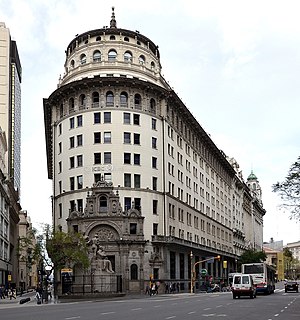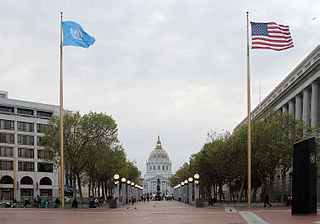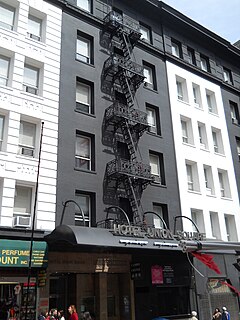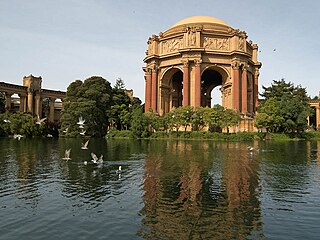
The Tower of Jewels was the central building at the Panama-Pacific International Exposition, the 1915 world's fair held in San Francisco, California.

The Tower of Jewels was the central building at the Panama-Pacific International Exposition, the 1915 world's fair held in San Francisco, California.
Designed by architect Thomas Hastings, of the firm of Carrère and Hastings, [1] the combination triumphal arch-and-tower was 435 feet (132.59 m) tall. It was covered with more than 100,000 1-7/8 inch (47 mm) diameter Novagems, cut glass faceted "jewels", that sparkled in the sunlight, and were illuminated at night by more than fifty spotlights. Originally named just The Tower, the "appellation 'of Jewels' became an addition to the original title, after the tower was thus gorgeously arrayed." [2]
In front of the Tower, the Fountain of Energy flowed at the center of the South Gardens, flanked by the Palace of Horticulture on the west and the Festival Hall to the east. The arch of the Tower served as the gateway to the Court of the Universe, leading to the Court of the Four Seasons to the west and the Court of Abundance to the east.
The Tower was a temporary structure, constructed of staff, a combination of plaster and burlap-like fiber applied over a skeleton structure of wood and steel. It was demolished following the Exposition. The Novagems that adorned the tower were removed prior to demolition, and a small brass medallion attached to each "jewel" indicating that it hung on the tower during the exposition. These jewels were individually boxed and sold for $1.00 each.

The Spanish Colonial Revival Style is an architectural stylistic movement arising in the early 20th century based on the Spanish Colonial architecture of the Spanish colonization of the Americas.

The Panama–Pacific International Exposition was a world's fair held in San Francisco, California, United States, from February 20 to December 4, 1915. Its stated purpose was to celebrate the completion of the Panama Canal, but it was widely seen in the city as an opportunity to showcase its recovery from the 1906 earthquake. The fair was constructed on a 636 acre(1 sq. mi., 2.6 km2) site along the northern shore, between the Presidio and Fort Mason, now known as the Marina District.

The Palace of Fine Arts is a monumental structure located in the Marina District of San Francisco, California, originally constructed for the 1915 Panama–Pacific International Exposition to exhibit works of art. Completely rebuilt from 1964 to 1974, it is the only structure from the exposition that survives on site.

The Civic Center in San Francisco, California, is an area located a few blocks north of the intersection of Market Street and Van Ness Avenue that contains many of the city's largest government and cultural institutions. It has two large plazas and a number of buildings in classical architectural style. The Bill Graham Civic Auditorium, the United Nations Charter was signed in the Veterans Building's Herbst Theatre in 1945, leading to the creation of the United Nations. It is also where the 1951 Treaty of San Francisco was signed. The San Francisco Civic Center was designated a National Historic Landmark in 1987 and listed in the National Register of Historic Places on October 10, 1978.

The Panama–California Exposition was an exposition held in San Diego, California, between January 1, 1915, and January 1, 1917. The exposition celebrated the opening of the Panama Canal, and was meant to tout San Diego as the first United States port of call for ships traveling north after passing westward through the canal. The fair was held in San Diego's large urban Balboa Park.
Adolph Alexander Weinman was a Germany-born American sculptor and architectural sculptor.

Audrey Marie Munson was an American artist's model and film actress, considered to be "America's first supermodel." In her time, she was variously known as "Miss Manhattan", the "Panama–Pacific Girl", the "Exposition Girl" and "American Venus." She was the model or inspiration for more than twelve statues in New York City, and many others elsewhere. Munson appeared in four silent films, including unclothed in Inspiration (1915). She was one of the first American actresses to appear nude in a non-pornographic film.

Alexander Stirling Calder was an American sculptor and teacher. He was the son of sculptor Alexander Milne Calder and the father of sculptor Alexander (Sandy) Calder. His best-known works are George Washington as President on the Washington Square Arch in New York City, the Swann Memorial Fountain in Philadelphia, and the Leif Eriksson Memorial in Reykjavík, Iceland.

San Francisco City Hall is the seat of government for the City and County of San Francisco, California. Re-opened in 1915 in its open space area in the city's Civic Center, it is a Beaux-Arts monument to the City Beautiful movement that epitomized the high-minded American Renaissance of the 1880s to 1917. The structure's dome is taller than that of the United States Capitol by 42 feet (13 m). The present building replaced an earlier City Hall that was destroyed during the 1906 earthquake, which was two blocks from the present one.

Charles Allan Grafly, Jr. was an American sculptor, and teacher. Instructor of Sculpture at the Pennsylvania Academy of the Fine Arts for 37 years, his students included Paul Manship, Albin Polasek, and Walker Hancock.

Thomas Hastings was an American architect, a partner in the firm of Carrère and Hastings.
Swanton is a small community in an unincorporated area of Santa Cruz County on the Pacific coast, situated about 5 miles (8.0 km) north of the town of Davenport, to the east of State Route 1 on Swanton Road. The US Geological Survey designates Swanton as a populated place located at latitude and longitude 37.06417°N 122.22639°W with an elevation of 135 ft (41 m). The ZIP Code is 95017 and the community is inside area code 831.

Hotel Union Square is located at 114 Powell Street in San Francisco, California. It was built in 1908, had a speakeasy in the basement during the Prohibition Era, and Dashiell Hammett was a patron.

The Marina District is a neighborhood located in San Francisco, California. The neighborhood sits on the site of the 1915 Panama–Pacific International Exposition, staged after the 1906 San Francisco earthquake to celebrate the reemergence of the city. Aside from the Palace of Fine Arts (POFA), all other buildings were demolished to make the current neighborhood. The Marina currently has the highest non-Hispanic white resident percentage of any recognized neighborhood in San Francisco.

City National Plaza is a twin tower skyscraper complex on South Flower Street in western Downtown Los Angeles, California, United States. It was originally named ARCO Plaza upon opening in 1972.

Ralph Ward Stackpole was an American sculptor, painter, muralist, etcher and art educator, San Francisco's leading artist during the 1920s and 1930s. Stackpole was involved in the art and causes of social realism, especially during the Great Depression, when he was part of the Public Works of Art Project, Federal Art Project of the Works Progress Administration, and the Treasury Department's Section of Painting and Sculpture. Stackpole was responsible for recommending that architect Timothy L. Pflueger bring Mexican muralist Diego Rivera to San Francisco to work on the San Francisco Stock Exchange and its attached office tower in 1930–31. His son Peter Stackpole became a well-known photojournalist.

The Old Federal Reserve Bank of San Francisco Building, now known as the Bently Reserve, was the main headquarters building of the Federal Reserve Bank of San Francisco for nearly sixty years. The building is located at 400 Sansome Street, in the Financial District of San Francisco. Designed by George W. Kelham, the building has an Ionic colonnade that is pure Beaux-Arts, while the upper building is in the new Moderne fashion of 1924. The banking lobby at the Sansome Street entrance contains a mural by Jules Guerin, the artist who created the palette for the 1915 Panama–Pacific International Exposition. The Old Federal Reserve was added to the National Register of Historic Places in 1984.

Furio Piccirilli was an Italian-born American sculptor and one of the Piccirilli Brothers.

Walter D'Arcy Ryan was an influential early lighting engineer who worked for General Electric as director of its Illuminating Engineering Laboratory. He pioneered skyscraper illumination, designed the Scintillator colored searchlights display, and was responsible for the lighting of the Panama-Pacific International Exposition in San Francisco and the Century of Progress Exposition in Chicago, in addition to the first complete illumination of Niagara Falls. He combined illumination into both an art and a science.

The California Quadrangle, California Building, and California Tower are historic structures located in Balboa Park in San Diego, California. They were built for the 1915–16 Panama-California Exposition and served as the grand entry to the Expo. The buildings and courtyard were designed by architect Bertram Goodhue. They were added to the National Register of Historic Places on May 17, 1974. They now house the Museum of Us.
Coordinates: 37°48′13″N122°26′31″W / 37.80373°N 122.4419°W